Oscar-nominated Killers of the Flower Moon puts Native American clothing design centre stage
How Osage ribbon work got top billing in Oscar-nominated Killers of the Flower Moon, Martin Scorsese’s true-crime epic
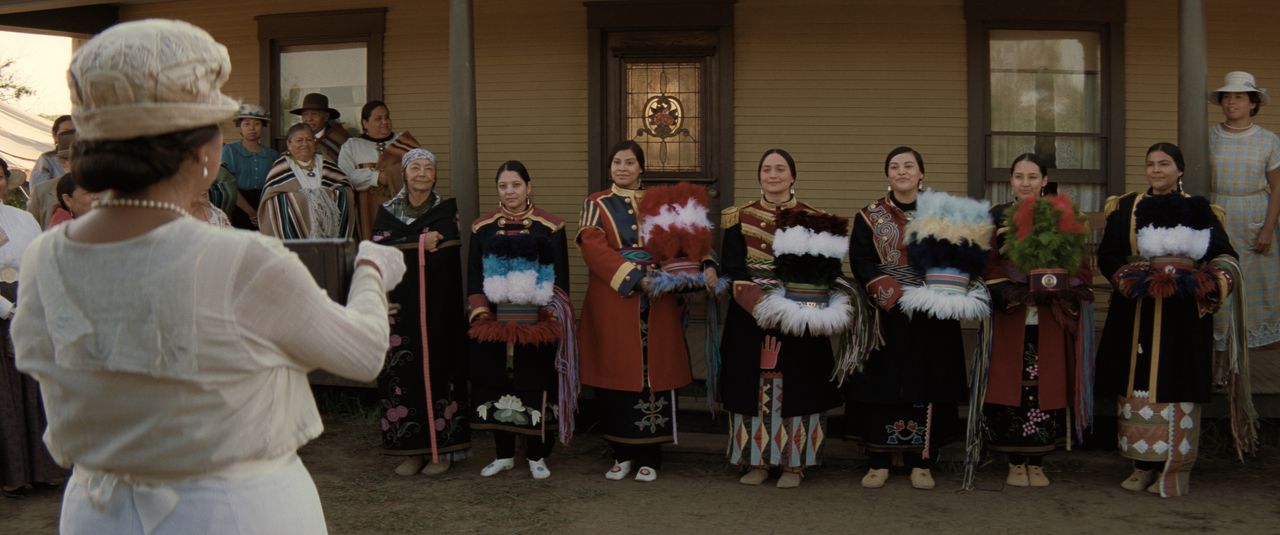
The Oscar nominations are out and, as widely expected, Martin Scorsese's Killers of the Flower Moon, the historic crime-drama starring Leonardo DiCaprio, Lily Gladstone and Robert de Niro, is up for Best Picture. And while it may not have the blockbuster appeal or tech trickery of hot contender Oppenheimer, it is as masterful a piece of storytelling as you are ever likely to see.
Based on David Grann’s 2017 book of the same name, the film explores the infamous FBI hunt for the perpetrators of a series of murders of oil-rich Osage Native Americans in 1920s Oklahoma. Scorsese has created a deeply layered narrative that not only highlights a monstrous miscarriage of justice but that, at its core, seeks to underline centuries of Osage culture.
Osage ribbon work and Killers of the Flower Moon
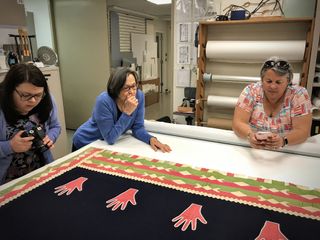
Jan Jacobs (centre) surveying Osage ribbon work at the Metropolitan Museum of Art New York
Martin Scorsese is a master at using a character’s style of dress to make a broader point, so it’s no surprise that the film’s costumes play a central role. The graphic designs and unique ribbon work that made Osage clothing a talking point as far back as people can remember are a particular highlight.
Georgeann Robinson was a garlanded Osage ribbon worker and activist whose work appears in museum collections across the USA, including at the Metropolitan Museum of Art New York. Her daughter, Jan Jacobs, who also took up the technique, explains how the craft emerged in 19th-century Oklahoma: ‘My mom always used to laugh and say: "Thanks to the French Revolution, we had all these ribbons”,’ she recalls, referring to the French fur traders travelling along the Missouri River region in the American Midwest in the early 1800s. Apart from furs and other goods, they would barter exquisite ribbon offcuts with the Osage, a nomadic tribe they had befriended a hundred years before. Expensive ribbons and silk and satin trimmings had fallen out of fashion in post-Revolution France and were easy cargo for traders on the move.
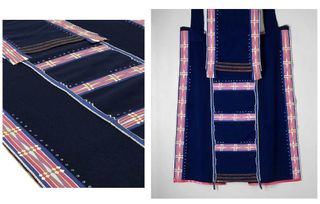
A piece by master ribbon-worker Georgeann Robinson was acquired by the Metropolitan Museum of Art New York
‘It’s one of the things that really interests me, because silk was kind of expensive all over the world then, and obviously this was from France, yet the idea of fancy ribbon work travelling across the world to be used in a new way is fascinating,’ says Jacobs, who also serves on various educational and arts boards, offering insight into the culture of American Indian and Alaska Native (AIAN) communities.
The first documentation of Osage ribbon craft was thought to have been by a Catholic priest, who wrote about a Pottawatomie woman's wedding dress. 'That was in 1802,' Jacobs says, ‘but the style was advanced, which suggests Osage women had been crafting with ribbons for a while, though no one had really seen it until then.’ The Osage were not the only American Indian tribe to use ribbons but, by all accounts, the techniques, graphic stories and colour combinations of their designs had a presence all their own.
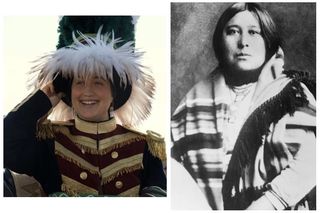
Lily Gladstone (left) plays Mollie Burkhart (right), the Osage woman whose story propels Killers of the Flower Moon
The skill involves using various strips of coloured ribbon, then layering them one on top of the other. A design is then cut out, which the workers stitch and fold into bold reams. ‘It amazes me to this day to think about how our women got these ribbons and how, over time, they figured out a way to make these beautiful patterns,’ Jacobs says. ‘I mean, needles were different then, thread was different, and scissors? Scissors were definitely different. Did these women have rulers? How did they come to make designs that are so neat and so precise? And silk was not easy to work with as it didn’t hold the fold. That’s why my mother always preferred a Swiss moiré, as it would hold a crease.’
Wallpaper* Newsletter
Receive our daily digest of inspiration, escapism and design stories from around the world direct to your inbox.
Georgeann Robinson was born into the Osage tribe, the Deer Clan, in 1917, at the height of the Osage murder scandal. She became an esteemed designer and influential civil rights activist and was key to a national revival of Osage ribbon skills in the 1950s, when she opened Red Man store in Pawhuska with her two sisters. Red Man store specialised in special-occasion clothing, such as wedding-wear and traditional Osage dress for men and women. As Jacobs observes: ‘I like that we make the men's suits with ribbons as well, because men wouldn't generally wear ribbons, but in this context, they do.’
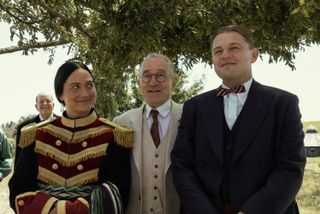
Lily Gladstone, who plays Mollie Burkhart in Killers of the Flower Moon, pictured with Robert De Niro and Leonardo DiCaprio, wears an Osage needle work belt in the film's wedding scene
The Osage dances take place every June, across each of the three Osage villages, with families from Oklahoma communities taking part. The In-Lon-Schka is a ceremonial dance highlighting community harmony and spirituality and underlining the Osage ways of life. The dances continued all the way through the 1920s, during the Osage murders, the horror at the centre of Killers of the Flower Moon. For a moment at both the beginning and the end of the film, hundreds of Osage citizens, dressed in traditional ribboned suits, are seen taking part in a dance in all their finery. And, when we see Mollie Burkhart (played by Lily Gladstone) marry her husband Ernest Burkhart (Leonardo di Caprio), the women are bedecked in ribbon-work skirts, and embroidered finger-work belts.
Jacobs, however, is keen to note: ‘Ribbon and needle-work pieces were and are not for everyday wear. My grandmother wore a wraparound skirt every day with just a simple Osage shirt and moccasins, exactly as you see Lily Gladstone wear for most of the film.’ Jacobs, who saw the film early on, believes that ‘the costuming part of the film is very accurate, because in the 1920s, during that transition time, a lot of women still dressed as my grandmother did, while some of the younger ones were dressed in the flapper style of the times.’
Scorsese’s films always triumph on detail, and Jacqueline West, Killers of the Flower Moon costume designer has been meticulous in her quest to represent traditional dress down to the last detail. Working closely with costume consultant and Osage woman Julie O’Keefe, who corralled a host of community craftspeople to work alongside West during the film, was crucial.
A precision craft reaches a new audience
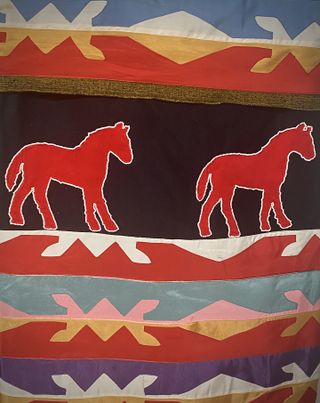
Horses often appear in Osage ribbon work
Precision craft has always played a part in Jacobs’ family story. And, though she wasn’t particularly keen to take up ribbon work as a teenager, her mother’s being awarded the National Heritage Fellowship in 1982 for her revitalisation of the art inspired her to learn. Today, as well as teaching, Jacobs and her handwork are in demand by museum curators keen to preserve or duplicate Osage ribboned garments when the original is deemed too fragile to display.
‘We’re in a good place right now,’ she tells me of the tradition’s overall health. ‘When my mother and her sisters started the store, there weren't a lot of women doing ribbon work. But, you know, it's not an easy task, so people tend to keep pieces that have been passed down, in closets and trunks, ready to pull out for the dance. It hadn't gone away, but she and her sisters helped to shine a light on it, as they were concerned that the tradition might disappear.’
Jacobs tells me her niece, Lisa, is a fine ribbon worker. ‘She does beautiful work. When she was in high school, she'd come down in the summers and spend time with grandma and grandpa and just like me, she would go to the store, and she would do beaded edges and learn by being around it. So, I do think there is a chance it will always survive.’
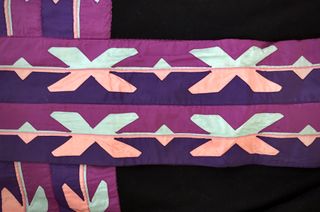
A sample of master ribbon-worker Georgeann Robinson's work
Killers of the Flower Moon will, hopefully, reveal Osage culture and arts to a whole new audience. ‘I did enjoy the film,’ Jacobs says. ‘It was a hard film because it's a hard story, but I think it is important for people to see it and to know there is much more to this story than what the movie could show, even in three and a half hours. Many terrible things have happened to Native people, but we’re resilient and vibrant and we are very tied to our culture. So, I am glad that people are seeing the beauty of the ribbon work and the creativity and care that people take to keep it going because it is a part of who we are.’
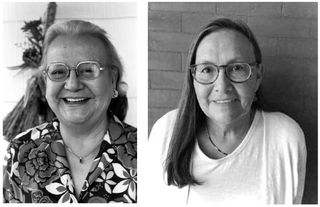
Master ribbon-worker and activist Georgeann Robinson (left) and daughter Jan Jacobs (right)
Caragh McKay is a contributing editor at Wallpaper* and was watches & jewellery director at the magazine between 2011 and 2019. Caragh’s current remit is cross-cultural and her recent stories include the curious tale of how Muhammad Ali met his poetic match in Robert Burns and how a Martin Scorsese Martin film revived a forgotten Osage art.
-
 Patek Philippe brings 15 new timepieces to Watches and Wonders 2025
Patek Philippe brings 15 new timepieces to Watches and Wonders 2025The Swiss manufacturer showcases its intricate complications and elegant designs at the annual trade show with a suite of new models
By Anna Solomon Published
-
 Watches & Wonders 2025: preview Richemont’s latest innovations, on show at the Geneva watch fair
Watches & Wonders 2025: preview Richemont’s latest innovations, on show at the Geneva watch fairDiscover eight enticing timepieces from the luxury group, showcased this week at the Geneva fair
By Simon Mills Published
-
 Masters of midcentury modern design and their creations spotlighted in new book
Masters of midcentury modern design and their creations spotlighted in new book‘Mid-Century Modern Designers’ is a new book from Phaidon celebrating those who shaped the period and their notable creations, from furniture to objects
By Tianna Williams Published
-
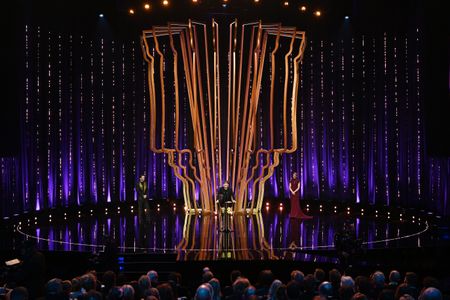 BAFTA 2024 stage design pays tribute to the history of film animation
BAFTA 2024 stage design pays tribute to the history of film animationThe 2024 BAFTA Film Awards celebrated the best of the past year’s films, with an elegant stage by Yellow Studio, which pays tribute to the history of film animation
By Tianna Williams Published
-
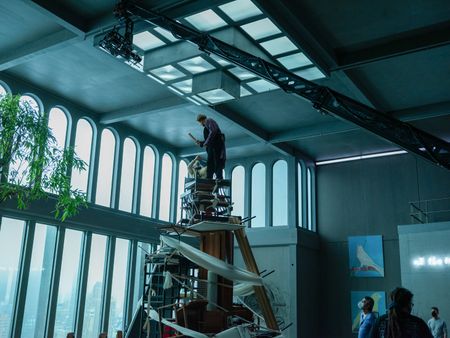 ‘Inside’ movie set: capitalism meets brutalism in the art- and design-filled thriller starring Willem Dafoe
‘Inside’ movie set: capitalism meets brutalism in the art- and design-filled thriller starring Willem DafoeThorsten Sabel takes us through the making of ‘Inside’, the movie starring Willem Dafoe as a thief trapped in an art- and design-filled penthouse inspired by Oscar Neimeyer architecture
By Rosa Bertoli Published
-
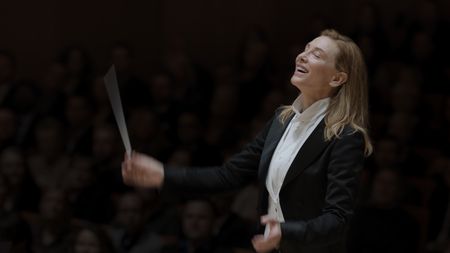 Inside Tár: behind the scenes of the Oscars-nominated movie’s set designs
Inside Tár: behind the scenes of the Oscars-nominated movie’s set designsWe speak to production designer Marco Bittner Rosser, behind the Tár movie set designs, to delve deep into the unique aesthetics of Lydia Tár’s world
By Rosa Bertoli Last updated
-
 What is the meaning of home? Here’s what designers say.
What is the meaning of home? Here’s what designers say.On the occasion of World Refugee Day (20 June 2021), Danish design brand Lucie Kaas asked designers from 11 international studios to explain what ‘home’ means to them
By Rosa Bertoli Last updated
-
 Watch Studio Pepe’s otherworldly design manifesto
Watch Studio Pepe’s otherworldly design manifestoThe Milanese design duo have gathered their inspirations and pieces from the past year into a magical video
By Rosa Bertoli Published
-
Travel friendly: Cottage Eight Films captures the spirit of travel in moving image form
By Pei-Ru Keh Last updated
-
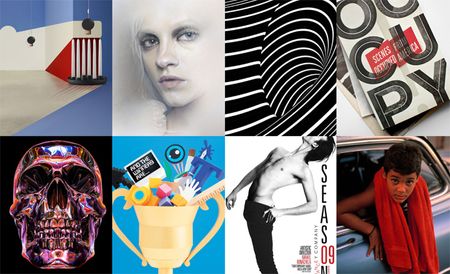 Semi-Permanent creative conference
Semi-Permanent creative conferenceBy Lauren Ho Last updated
